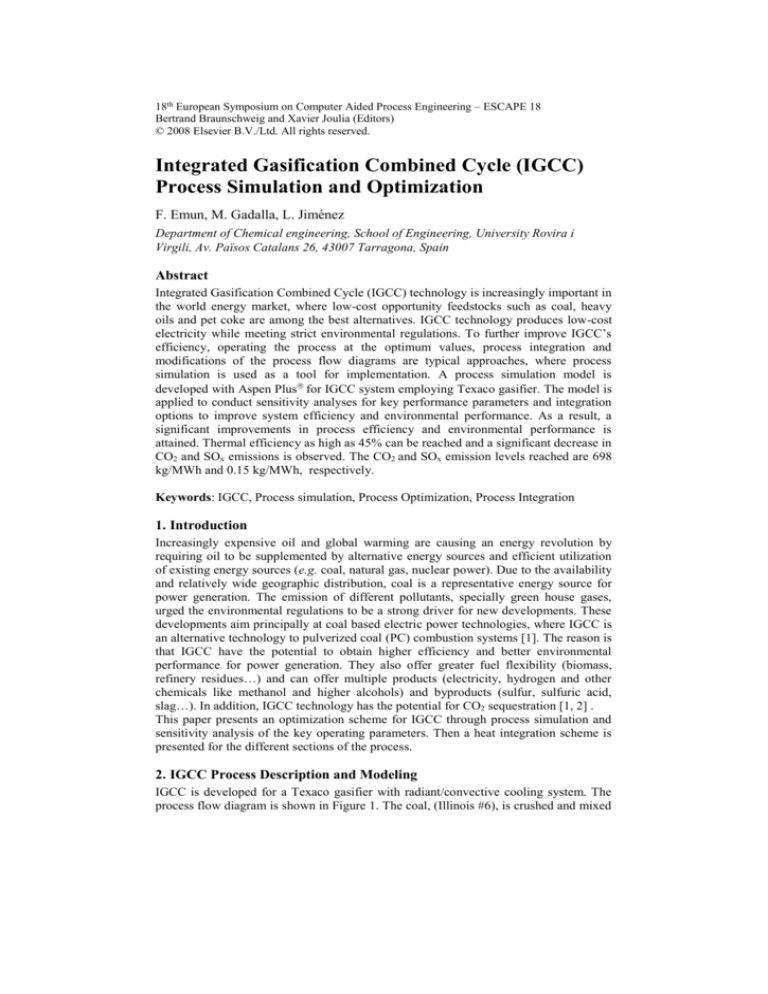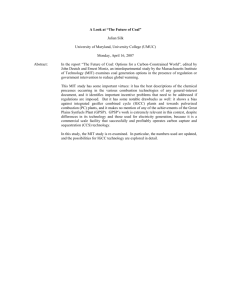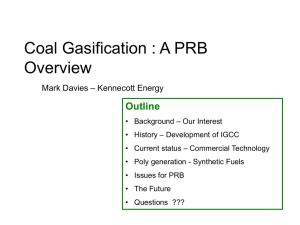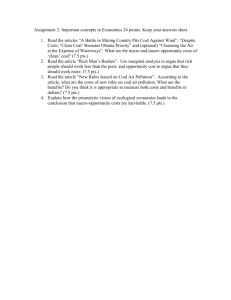
18th European Symposium on Computer Aided Process Engineering – ESCAPE 18
Bertrand Braunschweig and Xavier Joulia (Editors)
© 2008 Elsevier B.V./Ltd. All rights reserved.
Integrated Gasification Combined Cycle (IGCC)
Process Simulation and Optimization
F. Emun, M. Gadalla, L. Jiménez
Department of Chemical engineering, School of Engineering, University Rovira i
Virgili, Av. Països Catalans 26, 43007 Tarragona, Spain
Abstract
Integrated Gasification Combined Cycle (IGCC) technology is increasingly important in
the world energy market, where low-cost opportunity feedstocks such as coal, heavy
oils and pet coke are among the best alternatives. IGCC technology produces low-cost
electricity while meeting strict environmental regulations. To further improve IGCC’s
efficiency, operating the process at the optimum values, process integration and
modifications of the process flow diagrams are typical approaches, where process
simulation is used as a tool for implementation. A process simulation model is
developed with Aspen Plus for IGCC system employing Texaco gasifier. The model is
applied to conduct sensitivity analyses for key performance parameters and integration
options to improve system efficiency and environmental performance. As a result, a
significant improvements in process efficiency and environmental performance is
attained. Thermal efficiency as high as 45% can be reached and a significant decrease in
CO2 and SOx emissions is observed. The CO2 and SOx emission levels reached are 698
kg/MWh and 0.15 kg/MWh, respectively.
Keywords: IGCC, Process simulation, Process Optimization, Process Integration
1. Introduction
Increasingly expensive oil and global warming are causing an energy revolution by
requiring oil to be supplemented by alternative energy sources and efficient utilization
of existing energy sources (e.g. coal, natural gas, nuclear power). Due to the availability
and relatively wide geographic distribution, coal is a representative energy source for
power generation. The emission of different pollutants, specially green house gases,
urged the environmental regulations to be a strong driver for new developments. These
developments aim principally at coal based electric power technologies, where IGCC is
an alternative technology to pulverized coal (PC) combustion systems [1]. The reason is
that IGCC have the potential to obtain higher efficiency and better environmental
performance for power generation. They also offer greater fuel flexibility (biomass,
refinery residues…) and can offer multiple products (electricity, hydrogen and other
chemicals like methanol and higher alcohols) and byproducts (sulfur, sulfuric acid,
slag…). In addition, IGCC technology has the potential for CO2 sequestration [1, 2] .
This paper presents an optimization scheme for IGCC through process simulation and
sensitivity analysis of the key operating parameters. Then a heat integration scheme is
presented for the different sections of the process.
2. IGCC Process Description and Modeling
IGCC is developed for a Texaco gasifier with radiant/convective cooling system. The
process flow diagram is shown in Figure 1. The coal, (Illinois #6), is crushed and mixed
2
F. Emun
with water to produce a slurry (35.5 % w/w water) and pumped into the gasifier with
oxygen. The gasifier operates in a pressurized, down flow, entrained design and
gasification takes place rapidly at temperatures higher than 1200 ºC. The raw fuel gas
produced is mainly composed of H2, CO, CO2, and H2O. The coal's sulfur is primarily
converted to H2S and smaller quantity of COS. This raw fuel gas leaves the gasifier at
1370 ºC along with molten ash and a small quantity of unburned carbon. No liquid
hydrocarbons are generated.
This gas/molten solids stream enters to a radiant syngas cooler (RSC) and convective
syngas cooler (CSC) sections. In this design, the mix of gas/solids from the gasifier
enters a radiant syngas cooling (RSC) system where cooling (815 ºC) is accomplished
by generating a high-pressure steam. A convective syngas cooling (CSC)/gas scrubbing
system cools the raw fuel stream to about 150 ºC (27.5 bars) by generating additional
steam. It uses a gas scrubber and a low temperature gas cooling/heat recovery section to
reduce the raw fuel gas stream to 40 oC, prior to entering a cold gas cleaning unit
(CGCU) for sulfur removal.
The properties of Illinois #6 coal and the data are reported by the Process Engineering
Division of the American Energy Institute (2000) [3]. Some data (operating conditions,
range of variables) are retrieved from the literature [4-6].
Sulfur
Coal
Water
Figure 1. Simplified diagram for IGCC [7].
3. Methodology
The flowsheet has several naturally grouped sections: coal preparation, gasification, gas
cooling and cleaning, acid gas removal, gas turbine, HRSG, steam cycle, etc... All
sections were rigorously modeled using Aspen Plus .
Simulation was controlled using FORTRAN routines and design specifications to
reduce the number of initial conditions and to adjust automatically those associated
variables. The main functional relationships (i. e. control structures) are: the amount of
coal input is a function of the gas turbine net power (272 MW), the amount of slurry
water depends of the coal input (35.5 %), the make-up water for the steam cycle
depends on the temperature of the stack gas (125 oC), the air input to the ASU is
determined by the gasifier net duty and the air to the gas turbine (GT) combustor is
fixed by the combustor net heat duty or the stoichiometric amount of air required.
Type the title of your paper
3
Since this is a large and complex model (seven nested loops, five control blocks and
many design specifications) it is very sensitive towards the loop’s break points (i. e. tear
streams) and their initial conditions. After detailed analysis, a specific computational
sequence was set up for the model, and the ranges of initial conditions were established
to improve the convergence. Sensitivity analysis and process integration are applied to
improve the efficiency and environmental performance of the process.
4. Process Optimization
The sensitivity of the process for different variables is analyzed. The variables studied
are: gasification temperature, combustion temperature, level of N 2 injection and solid
concentration of the coal slurry. The main parameters analyzed within each analysis are
thermal efficiency (LHV) (LHV), cold gas efficiency (CG), net power output per ton of
coal, O2:carbon ratio (O2:C) and air:clean syngas ratio (air:syn).
4.1. Effects of Gasification Temperature
The sensitivity of the process for the gasification temperature is done under the
operational range of temperatures where gasification can take place with slagging of the
ash (1250 ºC and 1550 ºC) [1]. As the gasification temperature increases, the thermal
efficiency decreases due to a decrease in the cold gas efficiency. This decline in cold
gas efficiency is due to a rise in the O 2:C ratio in order to combust more carbon to reach
high temperature. On the contrary, the total net power increases because the steam
turbine power output rises due to a higher amount of the slurry used for the same
quantity of gas turbine output; however, the net power output per ton of coal consumed
has a decreasing trend as the thermal efficiency.
The CO2 and SOx emissions per unit of power output increases due to the rise in the
coal consumption for the same level of GT power output. But the NO x emission per unit
of power output decreases very slightly due to a decline in the air:clean syngas ratio,
thereby lessening the thermal NOx formation.
4.2. Effects of Gas Turbine Inlet Temperature (Syngas Combustion Temperature)
The analysis is performed for a range of temperatures (T comb) around the base case
(1250-1550 oC). For an increase in Tcomb by 300 oC, thermal efficiency (LHV) increases
by 5%. Along with an increase in LHV, the CO2 and SOx emissions per unit power
output also decrease. This is due to the decrease in the level of coal consumption for the
same GT power output. But, the NOx emission increases because of an increase in
thermal NOx formation at higher temperatures. The carbon conversion efficiency, the
cold gas efficiency and the O2:C ratio remain almost constant because they are
independent of the combustor operating temperature.
4.3. Effects of Level of N2 injection
As the fraction of N2 injection to the GT combustor increases:
1. The thermal efficiency increases, due to a decrease in the slurry (coal) requirement as
more N2 is used to drive the turbine.
2. The net power output decreases due to a decrease in the steam turbine power output
as a result of the reduction in the coal flow.
3. The net power output per ton of coal input increases because of the decrease in coal
requirement for the same level of GT output.
4. The CO2, SOx and NOx emissions decrease due to the decrease in the coal
consumption and the diluting effect of the N2, thus inhibiting thermal NOx formation.
The carbon conversion efficiency, the cold gas efficiency and the O 2:C ratio remain
constant because they are independent of the varying parameter.
4
F. Emun
4.4. Effects of Solid Concentration in Coal Slurry
With the rise in solids concentration, the O2:carbon ratio decreases because the required
energy to vaporize and superheat the water decreases. Therefore the syngas heating
value increases because less coal is being used to supply energy for the gasification.
Due to this, the thermal efficiency and the net power output per ton of coal input
increase. The emissions per unit power of CO2, SOx and NOx slightly increase because
of the slight decrease in the total net power. The net power gets minimized with the rise
in solids concentration because the amount of steam produced in the HRSG gets down
as the coal consumption decreases.
4.5. Simultaneous analysis of the effects of Level of N2 injection and Syngas Combustion
Temperature
The thermal efficiency increases almost linearly with the increase in the combustor
temperature for all levels of N2 injection to the combustor (Figure 2). Therefore, the
power augmenting effect of the N2 flow is greater than its diluting effect in the
combustor.
Figure 2. Effects of simultaneous variations of the level of N2 injection and combustion
temperature on the thermal efficiency.
N2 injection level of 98% represents the practical upper bound on the total amount of N 2
available for injection, as venting is inevitable and N2 can be used as a coolant in the gas
turbine [4]. This value supposes that the combustor operates at the highest possible
temperature (depending on the turbine inlet temperature specification), thus producing
power with relatively high thermal efficiency.
5. Heat Integration
With the aim to improve thermal efficiency and environmental performance, the effects
of heat integration of the gasifier and GT combustor is analyzed. This study is
complemented by the integration of the air separation unit (ASU) and the gas cleaning
unit.
5.1. Heat integration of the Gasifier and the GT-Combustor
In this analysis, the gasifier is heat integrated with the GT-combustor and the level of
integration is optimized by varying the oxygen and air requirements of the gasifier and
combustor, respectively. As the gasification reaction is endothermic, its net heat duty is
kept zero so that no external heat is added to the system (except from the combustor).
5
Efficienc
y
Type the title of your paper
Figure 3. Dependence of a) Thermal efficiency; b) Cold gas efficiency and carbon conversion
efficiency; on heat integration of GT-combustor and gasifier.
Table 1. Stream data for the heat integration
Optimized Texaco gasifier
Heat integrated case
Tin(oC)
Tout(oC)
Duty(MW)
Tin(oC)
Tout(oC)
Duty(MW)
Cond. regen.
347
332
-12
347
332
-12
Oxygen
150
150
0
150
340
5.8
Figure 4. The sensitivity of the combustor and gasifier level of integration for the case
of ASU and gas cleaning units heat integration.
With the increase in the level of heat integration, the net power output increases, but the
net power per ton of coal consumed increases until it reaches a flat maximum (Figure
3a). The decrease in the O2:C ratio with the increase in the level of integration has a
positive effect on the thermal efficiency at first, because it favors the gasification
reaction (compared with the combustion reaction) and increases the cold gas efficiency.
Then, with further decrease in the O2:C ratio, the carbon conversion efficiency and, in
turn the cold gas efficiency, start to decrease (Figure 3b), thereby decreasing the thermal
efficiency. The air requirement in the combustor also decreases as the net heat duty of
the combustor increases. The last effect is to minimize the heat absorbed by the excess
air, to maintain the operating temperature.
5.2. Heat integration of the air separation unit (ASU) and the gas cleaning unit
The oxygen from the ASU to the gasifier is heat integrated with the condenser of the
amine regenerator (condenser regenerator) in the gas cleaning unit. This is proposed
due to the availability of high quality heat from the amine regenerator unit (Table 1).
6
F. Emun
The integration is done together with the analysis of the sensitivity of the process for the
level of combustor and gasifier integration which is already done in section 5.1.
As shown by Figure 4, the trend is similar with the previous analysis, and the maximum
is shifted to the left and the efficiency improved. The maximum efficiency is reached at
a combustor duty of 150MW (unlike 200MW in the previous case) due to the further
decrease in the O2:C ratio as the O2 inlet temperature to the gasifier increases.
6. Conclusions
Sensitivity of the process for different operating variables has been studied by taking the
best case (i. e. with high efficiency) as a base for the next analyses. At the end of these
analyses, the maximum thermal efficiency (LHV) attained is 45% with CO 2 and SOx
emissions of 698 kg/MWh and 0.15 kg/MWh, respectively. This result corresponds to a
gasification temperature of 1250 ºC, a combustion temperature of 1550 ºC, 98% of N 2
injection to the GT combustor, and a slurry solid concentration of 80%. For a practical
application of this improvement, among other considerations like the capacity of the
equipments and their cost, the flowability of the slurry at the high level of solids has to
be considered.
Heat integration of the gasifier and the combustor has revealed that the best value of net
heat duty for the integration is around 200 MW; but, the analysis for the heat integrated
case of the ASU and the gas cleaning units reveals that the best value of net combustor
duty for the integration is 150 MW. Figure 3 shows that the slope of variation in thermal
efficiency is very high in the right side of the maximum and therefore a slight variation
in operating conditions could lead to a significant loss of efficiency. Therefore, it is
advisable to operate at a slightly lower value of the net duty those problems during
operation.
Acknowledgement
F. Emun wishes to express his gratitude for the financial support received from the
Agencia de Gestió d’Ajuts Universitaris i de Recerca (AGAUR) from Generalitat de
Catalunya.
References
1. L. Zheng, E. Furinsky, 2005, Comparison of Shell, Texaco, BGL and KRW gasifiers as
part of IGCC plant computer simulations, Energy conversion and management, 46, 2005,
1767-1779.
2. G. Ordorica-Garcia, P. Douglas, E. Croiset, L. Zheng, 2005, Technoeconomic evaluation
of IGCC power plants for CO2 avoidance, Energy conversion and management, 47, 2006,
2250-2259.
3. W. Shelton , J. Lyons, 1998, Texaco gasifier base cases PED-IGCC-98-001, US
Department of Energy, Process Engineering Division, 2000, 1-52.
4. H. Christopher, Y. Zhu, 2006, Improved system integration for integrated gasification
combined cycle (IGCC) systems, Environ. Sci. Technol., 40, 2006, 1693-1699.
5. S. Sugiyama, N. Suzuki, Y. Kato, K. Yoshikawa, A. Omina, T. Ishii, K. Yoshikawa, T.
Kiga, 2005, Gasification performance of coals using high temperature air, Energy, 30,
2005, 399-413.
6. J. Minchener, 2004, Coal gasification for advanced power generation, Fuel, 84, 2005,
2222-2235.
7. G. Booras, N. Holt, 2004, Pulverised coal and IGCC plant cost and performance estimates,
Gasification technologies conference, Washington DC, October 2004.









